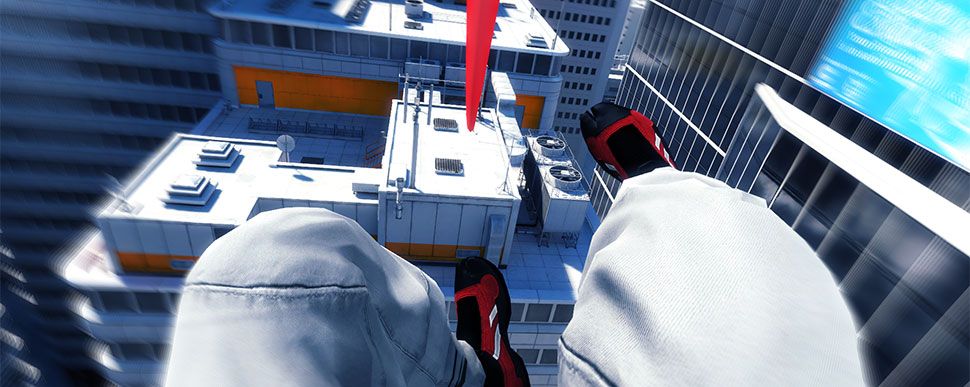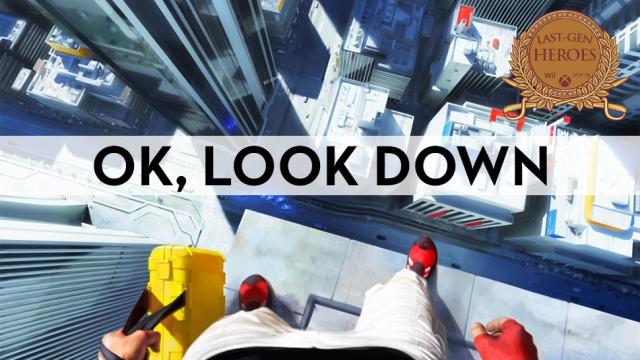I could write about Mirror’s Edge all day. About how much I love it, how important it’s been to this generation of gaming. I could take about its visual design, which remains as fresh and iconic today as it did back in 2009. I could take about Magnus “Solar Fields” Birgersson’s wonderful score. Instead, though, I’m going to talk about something a little more real.
Music and colours are the kind of things that hang heavy on your experience of a game long after you’ve stopped playing, like the scent of a loved one still on a pillow long after they’ve left the bed.
But while you’re actually playing Mirror’s Edge, you barely notice them, because you’re so busy running around like a lunatic, jumping over rooftops, scrambling up ladders and sliding under air ducts.
While you’re doing all that, people will often say “Oh, it’s cool I can see my hands and feet”, but those are just feedback indicators. Plenty of first-person games let you see your feet. The thing Mirror’s Edge did so well was attach them to a body that moved like a human being, not a floating camera attached to an arm holding a gun.
It’s something DICE are the masters of. And yeah, there’s a physicality to all their recent titles, Battlefield 3 especially, but it’s in Mirror’s Edge that it feels most real, most heavy.
I hate the way most players move in first-person games. Hate it. The genre is specifically built to immerse you in the action, but its games too often have you slide softly across a room, or zip gracefully in a sprint. Human beings don’t move like that!
We lumber. Even our most athletic and graceful specimens – and you’re controlling one in Mirror’s Edge – take heavy steps and run out of breath. Our vision shakes as we sprint, heads bobbing up and down. When we jump, we don’t activate anti-gravity boots, we’re leaping off leg muscles and propelling a human body. It’s messy, precarious.
The way Mirror’s Edge models this so well is what makes it such an important game. Earlier this week I criticised some first-person titles for using this generation’s improved hardware as a way to simply turn up the volume. What DICE did with Mirror’s Edge, though, was use it to create a way of moving in a video game that had never been done that well before. Or, to be honest, since.

It’s why I love the rooftop chase sequences of the game so much. They’re maybe my favourite moments of gaming in years, because they take what other games use as tedious roadblocks to level progression – jumping a gap, climbing a box – and by making them feel real transform them into anxious, death-defying stunts.
Sure, it’s not as sexy a sell as a room full of explosions, and given Mirror’s Edge’s (initial) lukewarm response surely didn’t resonate as well either, but this series isn’t about praising the best-selling or highest-rating games. It’s about singling out the real heroes of the last generation, and the fact this game took the effort to do the term “first-person” justice means it deserves to be lauded as one.
Last-Gen Heroes is Kotaku’s look back at the seventh generation of console gaming. In the weeks leading up to the launch of the PlayStation 4 and the Xbox One, we’ll be celebrating the Heroes — and the Zeroes — of the last eight years of console video gaming.

Comments
23 responses to “Mirror’s Edge Felt Real, And That’s What Made It So Special”
Couldn’t agree more. Mirror’s Edge is by far the best first-person game I’ve ever played, and one of my favourite games of all time.
Yeah can’t wait for number 2.
I loved the game, but for some reason I always felt something was missing. Like it had a bigger scope but they couldn’t quite do it. So it felt a little too linear, albeit the game giving you a false sense of scale.
So I’m really looking forward to the next one to see if they’ve opened it up a bit.
I’m on a horse?
I loved this game. On the other hand it deserved to fail. I know the time spent vs cost view is unpopular (and I agree quality is also an important consideration), but I finished this game in less than 3hrs first time through. It just wasn’t worth full retail for the amount to content provided. It made it really hard for me to recommend it to other people.
I’m hoping the sequel provides better peripheral awareness, less shooting, and has a more substantial story mode. That would make it a really great title in my view.
Depends if you played the time-trials or just the single-player campaign. I know a lot of folks got plenty of mileage out of that mode. More than out of the campaign.
Yeah – that’s true. I still don’t feel that was a lot of content, so much as people replaying the content over and over. Not for most people.
I did not buy it when it first came out purely because I read it was very very short. When I brought it on steam for I think $15 I thought it was great……I reckon if they released it for $30 it would have made more money than releasing it for full price. Sort of like they did with the last call of juarez. For $30 gunslinger is a great game, if I paid $80 for it I would not have liked it at all.
Yeah – ME felt like a $20 downloadable title to me.
3hrs wow – took me almost two years! (Granted I don’t play a game straight thru but you must be pretty good to knock it over in hours)
The thing is, most reports were consistent with my experiences. Obviously, I didn’t complete the time trials, but the campaign was easily a ‘rent not buy’ situation.
I know i’m in the minority (apparently), but I really didn’t find it that amazing.
It was literally a cleverly disguised hallway runner.
The ‘hallway runner’ part was really only true for part of the time. See below @shepard comment about looking up different ways of getting places.
I’m guessing to many folks it only seemed like there was one obvious way to do things, but that’s because of how your brain works. Just try watching someone else who thinks completely differently to you try to play Portal 1-2. It’s amazing how often they’ll simply click with a puzzle that might’ve taken you a while but struggle with something you consider obvious.
I really loved the game, but I thought I was in the minority gathering from comments I’ve seen around 😛
I thought it was ridiculous that when i went onto youtube, how MANY different ways people were finding to complete the level in the fastest way possible or the most survivable route etc… This game has great replayability if your looking for new ways to run. I remember when this came out in 2008, how excited i was for it simply because it just looked so different from everything else out there
Easily in my top 10 of all time. I hope the sequel takes on board several of the criticsms (story) to make the next one unforgettable 🙂
Best FPS this gen
Yeah it was pretty good for an FPS albeit having not much of the S. (A good thing!)
I think we should call it an FPR. First Person Runner. 😛
One of the best games ever made ^_^
Open World free-running/exploring with that amazing aesthetic and music? Sign me up.
Going to Day One the shit out of 2.
Adored number 1. The gunplay was off, but I’m convinced it was by design to discourage you from even using a weapon. You’re doing it wrong if you use a gun in that game.
This article makes me happy. I’ve played through this game so many times it’s ridiculous because it really felt like something unique compared to all the FPSs I’ve played over the years. The sense of movement is conveyed awesomely and for me the controls just seemed to flow excellently. Great soundtrack didn’t hurt either 😛
The problem though is the nausea that results when you add the bobbing into running and walking
Yes. I remember the game making me feel ill if I played for too long because of the movement.
LOL it made my wife sick to watch it!
It’s for that reason that i’m looking forward to the Oculus Rift, but really not looking forward too it as well.
That game looks good! I own it too. I better actually give it a go!
+100
I absolutely loved this game. I’m a fan of all things FPS, so was intrigued with this when a friend mentioned to me how good it was, and it was more about the running / acrobatics / parkour than shooting.
An FPS that doesn’t shoot? How strange, count me in! I love games that take me out of my comfort zone. Not only with the heights thing (which I’m not a fan of) but the fact you have to THROW DOWN YOUR WEAPONS if you want to run/climb! :O That was one of the biggest things for me to do. And I LOVE my guns.
One of the most incredible moments was I was on the run through a mall, I turned a corner to see 2 security guards running in my general direction. I rounded a pylon and slid-kicked into a guard, taking him down and dropping his gun. I promptly picked up the pistol, turned and killed the other guy with a single shot to the head. I then had to THROW my gun down and keep running… one of the best gaming moments I’ve had… ever.
Bring on ME2!
It was a very nice change of pace, I actually haven’t finished it yet but I’ve been playing it recently, and I love the movement and physicality of it. Hope number 2 improves on everything, and DICE downplays weapons even more, or entirely.
One of the best games ever made ^_^ yep
This is a great article on the fact that in most first person games, the player feels too constant or too precise, Mirror’s Edge showcased that the character can have a realistic feel to it while not being physically limiting either. First-Person generally forgets about the second part, the person and instead focuses on how many bullets you can fire out of a gun in a matter of seconds. First-Person wasn’t ever really a game genre that I ever really liked but, for the contrast to the ordinary Mirror’s Edge this stood out to me.